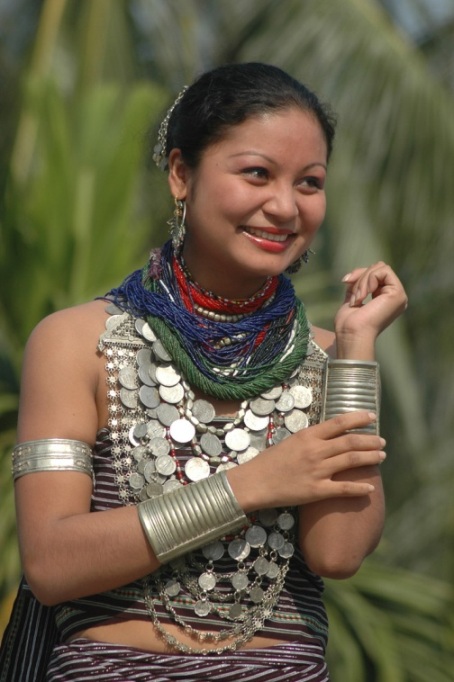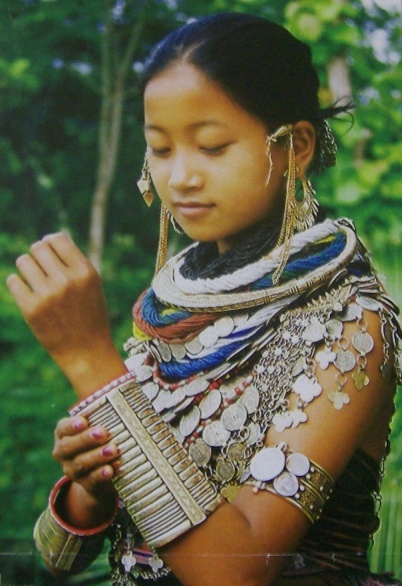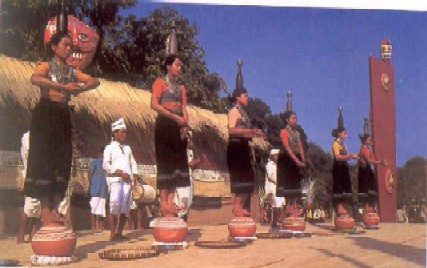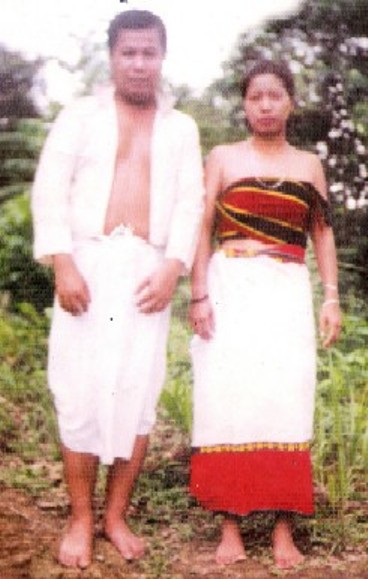|
Meska Group & Molsoi
Group
|
The Reang clans are divided into two
main groups:
(1) Meska,
(2) Molsoi.
 (1)
Meska Group:
it is divided into seven
sub groups or dofa, these are as follows:
(1)
Meska Group:
it is divided into seven
sub groups or dofa, these are as follows:
•
Meska :- means the lemon
tree in Kuki language. There were plenty of
lemon trees where the forefather of this dofa used to
live.
•
Mwsa :- means tiger in Kokborok. It is
said that the forefather of this dofa was brought up by
a tigress in his child hood like the Romulus and Ramous
of ancient Rome.
•
Chorkhi :-Chorkhi means Spinning wheel
in Kokborok, it is said that one Riang chief was
speaking obscene about his daughter in-low, when his
friends started spinning the spinning wheel to musk the
obscene of the chiefs. So the descendent are named
after the chorki.
•
Raikwchak :-Rai means cane, kwchak
means red in Kokborok; it is said that the fore father
of this dofa used to wear cane made red colour
armlet.
•
Wairem :-wai means Tripura, rem means
mix/hybrid in kuki language. It is said that they are
descendent of Riang man and kuki woman.
•
Tokma yakcho :-Tokma means hen, yakcho
means toes; the toes of the forefathers of this dofa
resembled to that of hen.
•
Twimuiyafak :-means tortoise in Riang
dialect, the fore father of this dofa were suffering
from white patches like the tortoise chest.
(2)
Molsoi Group:
This group is sub
divided into six groups, which are as follows:
•
Molsoi :-is the derivatives of moso,
which means chilli in Kokborok. Their fore fathers
first settled in the chilli field of kukis. Since they
were called in that name.
•
Apet :-Apet means is a type of fish in
Kokborok. The fore fathers' belly was big like the
belly of Apet fish.
•
Nogkham :-nok means house, kham means
burnt in Kokborok; once the fore father of this dofa's
house were burnt to ashes since then they were termed
in this name.
•
Chongpreng :- means a type of musical
instrument, it is said that the fore father of this
dofa used to survive by playing this musical instrument
as they were suffering from ‘gungri' disease.
•
Yakstam :- means ring of finger, it is
said that the fore father of this dofa used to used to
wear ring and used to display proudly to others. This
dofa has been in extinct at present.
•
Riang kachko : Kachko means chief in
Kokborok, the fore father of this dofa were chiefs of
Riang.
Kotor Dofa: in the
above thirteen dofas there are 26 chiefs or heads, who
are designated as Kotor Dofa. Kotor means head dofa
means clan or group. The chiefs are divided into two
categories, Rai and
Kasko .
 The
Reangs are
primarily an agriculturist tribe. In the past they
mostly used to practise the ‘Huk' or Jhum
cultivation, like most other Tripuri tribes. But now
shifted to modern agriculture practice. Most of the
educated are employed in government job and many are
occupying very high post in administration. Some are
also started doing business also.
The
Reangs are
primarily an agriculturist tribe. In the past they
mostly used to practise the ‘Huk' or Jhum
cultivation, like most other Tripuri tribes. But now
shifted to modern agriculture practice. Most of the
educated are employed in government job and many are
occupying very high post in administration. Some are
also started doing business also.
Marriage
system:
The Riang is an endogamous tribe and
had very little contact with the Bengali or other sub
tribe of Tripuri. But recently there has been some
inter tribe marriages and inter caste wedding among
them. The marriage system is similar to other Tripuri
tribe of Tripura. There is no dowry system but the
bride-groom has to spend to father in-law's house for
two years before marriage is preformed. There are two
types of marriages; Haloksai, and
Haloksam. Parallel cousin marriage
is prevalent but declining. Cross cousin marriage
among the Riang is accidental. Child marriage is not
allowed, widow marriage is permitted. Widows are
prohibited to wear ornaments before one year is
passed after the marriage of husbands. Widow and
widower are forbidden to participate any entertaining
and enjoying programme or activity or attending such
activity within one year of death of their spouses.
Remarriage of widow and widower are allowed after one
year of death of the spouse. Monogamy is the present
day practice of the society.
Marriage is
arranged through the matchmaker
Andra , who goes to the prospective
bride's parent for negotiation. Then the brides party
is invited to finalise the marriage in
Koksumgma, while pork, fowl, rice,
rice bear are served. Marriage is settled to the
satisfaction of both the party. The
Ochai performs the wedding ceremony
on the nuptial day fixed.
The Riang widower
is not permitted to get marry to an unmarried virgin
girl. The Riang marriage bond is very strong and
Riang mean cannot divorce with out the consent of
wife. If any Riang is alleged for extramarital
relation ship and found to be true then they are
dealt with strict punishment and heavy penalty is
imposed upon.
Dress and
ornaments: The traditional dress of the
Riang is simple and plain like other Tripuri people.
Traditionally the men wear a hand woven loin cloth
and a piece of cloth as a wrapper for upper portion.
The women wear a long cloth called
Rignai , wraparound; from the waist
to down to the knees. A Riha ,
covering the chest, and Rikutu for
covering the whole upper half of the body, wears the
upper part of the body. These are woven by the Riang
women, which are colourful and very beauty full. But
now a days the educated mass are wearing all the
modern dresses like any other part of the world.
The Riang women
are very fond of personal decoration and take much
care for the makeup and hair-do. They love like other
Tripuri people, ornaments, flowers, and cosmetics.
Silver ornaments especially the necklace of silver
coins, the Rangbwtang have a pride
of place and status.
 Dance and
music:
Dance is very much integral part of the
Reangs clans daily life. No other Tripuri people are so
fond of dance like them. As a result the
Hojagiri folk dance of Reang
clan had achieved an unprecedented acclaim all over the
world. Hojagiri dance had been performed in
almost all the leading nations of the world,
and where ever it had been performed it had
own the hearts of people in folk dances.
Shri Satya Ram Reang was awarded Sangeet
Natak Academy for his life long dedication
for preserving, promoting, and coaching the
dance by Government of India.
Dance and
music:
Dance is very much integral part of the
Reangs clans daily life. No other Tripuri people are so
fond of dance like them. As a result the
Hojagiri folk dance of Reang
clan had achieved an unprecedented acclaim all over the
world. Hojagiri dance had been performed in
almost all the leading nations of the world,
and where ever it had been performed it had
own the hearts of people in folk dances.
Shri Satya Ram Reang was awarded Sangeet
Natak Academy for his life long dedication
for preserving, promoting, and coaching the
dance by Government of India.
Customs: most of the disputed and
differences are settled by the people of Kotor dofa,
that is by the Rai and Kasko of respective sub tribe.
It is done through the customary law of the
Reangs.
Whenever a disputes arise in the between the member
of the community, a meeting is called by the Rai. All
relevant arguments are heard and then justice is done
according to the principle of natural justice.
Whatever verdict or punishment is pronounced in the
judgment it is implemented with firm hand and
payments of penalty etc. are made then and there.
Religious
belief and practices:
Like other Tripuri
people they also belief many god and goddess. The
centre figures are those of fourteen gods and goddess
of Tripura. Their important festivals are same those
of prevailing in Tripura. These are Ker, Gonga mutai,
Goria, Chitragupra, Hojagiri, Katangi puja, Lampra
wathop. The religious observance are community in
nature, and each family has to contribute his part of
share of payment. It is called as
Khain`.
All the religious
festivals are arranged with the prior meeting of
chiefs. In such meetings political, social, and
religious matters of importance are discussed and
decided by the majority of the meeting.
The deities of the
Reangs are similar those of other Tripuri people.
These are Mutai Kotor or the supreme
deity Subrai ,
Twima- the presiding deity of river,
Mailungma -the goddess of paddy,
Khulungma -the goddess of cotton,
Goria- the god of wealth prosperity well being and
war, Kalaia brother of Goria,
Sangrongma -the deity of mother
earth, Haichuma -the goddess of
hill, Burasa -the god of jungle,
Thunairok -the god of death,
Bonirok -the god of evil spirit,
Noksuma -the goddess of house
holds.
The worship of
different deities are similar to the main stream
Tripuri people. Ochai , the priest
performs all the ceremony along with his helper. The
green bamboo pole is used as deity in most on the
cases. Different types of life stock like fowl, pig,
goat eggs, etc. are offered in the worship. The place
of worship is selected out side of the houses. Where
the offerings are dedicated in the names of the
deities in front of the wathop, green bamboo pole,
the symbol of god. But the Rangtou k
and Noksuma puja is held inside the
house only. Two earthen pots are filled with newly
grown rice and at top of the pot some oval pebbles
collected from huk specially. The
pebbles are called the fortune stone. And the pots (
Rondok) are decorated with the rice
powder, vermilion, and garlands. One is named
Mailungma, the other as Khulungma.
Rituals on
Birth of the baby: On the birth of the baby
many pujas are observed. These are Kebengma, Abu
suma, Khongkhonok kama, Maitukma etc. for the welfare
of the baby. The fowl, prawn, several leaves of trees
are needed. When the child grows up special form of
worship has to be performed.
Bukhuksini the seven-gurdian deities
of witches are pleased with sacrifice of a pig, four
fowls, and other things beside.
Ceremony
on death: The mortal remains are cremated.
The obsequies is done in two stages:
Broksakami and
Kothainami.
Broksakami: W hen a person dies his
corpse is first bathed with the
Chakhwtwi that is alkali water or
soap, and Mairangtwi that is water
obtained from the washing of raw rice. After that he
is dressed with new clean Rikutu ,
head is dressed with another piece of rituku like the
headgear. In case of woman rignai
and risa. Then a fowl is sacrificed
in front of the feet of the corpse. Later on an
earthen pot filled with mean and rice placed at the
feat of the deceased and it is followed by dance
rituals through out he night. Rice bear is
distributed to all the mourners excepting the family
members of the deceased. The next morning the body is
laid to rest on pyre and cremated usually near a
stream.
Kwthwinami: It is a ritual connected
with the respectful and well wishing offering to the
manes. Laotok or the soul deceased
remains under the control of the sisi
manji , the son of Buraha ,
for a year and it is said that sisi manji is the
protector of the soul. On the day of the
kathainaimi the widow of the
deceased offers dried rice, meat, fish, fruits, and
wine in the name of Laotok and
sisi manji on the
simangnok , then taking the burnt
bones or ashes go to the charinok. It is worshiped
for over a period of one year or he next
hangrai, when it is immersed in any
river or in Gumti River at
Dombur , according to the ability of
the family. In short the
religious culture of the Reang is similar to that of
other Tripuri of Tripura.
Go to Top
RUPINI CLAN
Origin
Sub-clan
Culture & Custom
Origin:
The Rupini is one of the clan of
Tripuri People.
It is presumed that the initial
habitation of Rupini people was at the
site of the origin of Twi Rupini,
which is supposedly situated at
present Asom state. When other clans
of the Tripuri migrated towards the
present Tripura state, they also
migrated along with other clans. It
needs to be mentioned that like all
other Tripuri peoples clans, they are
also part of the great Borok/Bodo
race. The Rupini river is still
flowing in the state.
 The mother tongue of Rupini is
Kokborok, like all other Tripuri
people which is also known as Tripuri
or Tiprakok, but for an unknown reason the Rupini had been included in the group
of 'Halam' in the census and in many
historical documents of Tripura. This
is illofical and unfounded by the
historical linguistic and
anthropolofical facts. With out
verifying these facts, the government
of India had also included in the list
of 'Halam' when they were given the
status of Scheduled Tribe under the
constitution of India. The inclusion
of Rupini in the Halam group must be
removed and included in the list of
Kokborok speakers Tripuri people.
The mother tongue of Rupini is
Kokborok, like all other Tripuri
people which is also known as Tripuri
or Tiprakok, but for an unknown reason the Rupini had been included in the group
of 'Halam' in the census and in many
historical documents of Tripura. This
is illofical and unfounded by the
historical linguistic and
anthropolofical facts. With out
verifying these facts, the government
of India had also included in the list
of 'Halam' when they were given the
status of Scheduled Tribe under the
constitution of India. The inclusion
of Rupini in the Halam group must be
removed and included in the list of
Kokborok speakers Tripuri people.
The first ancestors of the Rupini was
Ramni Chapia. While he was taking a
dip in Twi Rupini river he got a
stone, which he threw away only to
find again. This stone told the
ancestor that he is the god of
Twirupini river, his name is
'Tanfangrai' and they should worship
him, and they shall be known as
"Rupini sa". Even today this Rupini
god is worshipped every year by all
the Rupini in community level as well
as individual level.
Sub
clans of Rupini:
Rupini are divided into four sub
clans viz. 1) Kwcham Rasti 2) Kwtal
Rasti 3) Thaithak 4) Paithak. Among
them the Kwcham Rasti and Thaithak are
the majority. The head of each of
these sub clans are called 'Rai'
Each sub clans is devided into twelve
Panchi or Panji that is family line.
These are 1) Kajari 2) Tiyol 3)
Fungchau 4) Kerjang 5) Farute 6) Muria
7) Sutar 8) Paithokra 9) Sotoboroisa
10) Chuan mochomsa 11) Swmjang 12)
Mwrfangsa. This division had been made
during the time of king Sibrai, the
Greatest of Tripura kings.
The work distribution of the
Panjis
1)
Kajari: They are descendant of
the head of the clan. They are engaged
in the rituals of worshiping of all
festivals. Some time they were asked
to provide human of sacrifice to gods.
2)
Tiyol: they are the one who
are responsible for controlling the
society. They are also engaged for
enforcement of law and order of the
society.
3)
Fungchau: the are the informant
of the king. They are also a assigned
to collect funds for any social
function and rituals.
4)
Kerjang: they are holder of
umbrella of the king. Along side they
also have the responsibility to
protect the society and go for war and
provide solder for the warfare as and
when directed by the Tripura kings.
5)
Farute: they are the priest
clans. The performs all sorts of puja
or worshipping and rituals of
community and family level.
6)
Muria: they are the music
player in the occasion of the puja,
rituals, any ceremony and functions.
7)
Sutar: they are experts in
handicrafts, specially the bamboo
based products. The supply all sorts
of furniture and family article to
the king of Tripura.
8)
Paithokra: they are guard of
the kings. They also guard the temple
of kings and used to clean and
maintain the temples.
9)
Sutoboroisa: they are assigned
to fetch water for the king in any
royal festivals and ceremony of kings.
10)
Chuan mochomsa: their job was
to prepare and arrange wine and rice
beer for the king and the royal
festivals.
11)
Swmjang: they are assistant in
helping out the in the kitchen.
12)
Mwrfangsa: they are assigned to
collect vegetables and all other
kitchen requirement of the king and at
times of royal festivals.
Physical structure:
Like any other Tripuri people they are
also yellowish complexion, average
tall, eyes are small, nose is short,
mustaches and beards are sparse, jet
black hair that is al the feature of
borok race or mongoloid race.
Economy:
Like all other
Tripuri people they are also
agrarians. Earlier days they used to
do the shifting cultivation in the
hillock and slopes. Then they also
trained to plan land farming. Now many
Rupini are employed in government as
well as in private jobs. Many Rupinis
are highly educated and found in
medical engineering profession also.
Culture & Custom
Go to Top
Food habit: The main
staple diet of Rupini is rice like all
other clans of the Tripuri people.
Meat is the most fabourite dish, among
them the pork and the chicken are the
most sought after. In heydays they
used to go for hunting of deer, yak,
wild pigs, boars, etc. like most other
Tripuri people. Apart from the meat
they also love to take the fish both
dry and fresh one. The fermented fish, berma typical of Tripuri
dish is also a must to Rupini. Apart
from this they are also fond of taking
drinks, both rice beer and the home
distilled wine.
Religious belief:
The
religious belief of Rupini clan is
same like rest of Tripuri people with
little bit of variations. The concept
of god and spiritual belief are simple
like their own life. They have the
faith on the almighty god, also on the
evil spirit. Like the other clans of
Tripuri people, their ultimate and
greatest god is Sibrai or Subrai.
Other gods are also similar to those
of other community. These are
Thupnairau/Thumnairok, Bonirau/Boonirok,
Burasa, Noksupma /Noksuma Goria,
Khulumgma, etc. apart from these there
are like gods of sun, water or
Twibukma, and fire etc are being
worshipped.
Festivals:
The Rupini
also celebrates all the festival those
are celebrated by other Tripuri
people. These are Buisu or last day of
the year, Sena or Goria, Hojagiri, Ker,
Hangrai etc. There is hardly any
difference in celebration of the
festivals, other than minor variation
in the procedure and steps. On these
festival the pancake is the must item.
Young and old, men and women all enjoy
during these festival with their full
heart content and dance drink and song
were used to be integral parts of its.
So only the culture of Rupini people
also developed.
Sena:
This festival starts on the first
day of the Tripura new year, and last
for seven days. On the last day Goria
is worshipped. On the puja fowl, goat
etc are sacrificed, different types of
cakes, delicious dishes, and sweets
are prepared in every home. The
neighbours and the relatives are
invited in dine in the feasts. The
younger people pay tributes and
respects by touching the feet of the
elder in presence of burning lamps and
insence sticks.
Mainungma
khulum mung or Hojagiri: On
this day the mailuma mutai or the
goddess of paddy is worshipped. When
the new paddy just arrives from the
jhum, it is time to celebrate the
Hojagiri on the full moon day of aswin
or kartik of Tripura calendar or the
October-November month. It is
generally given in the evening when
the full moon rises in the sky. Some
how it coincides with the Hindu
Hojagiri laxmi puja, which probably
might have been influenced by Tripuri
Hojagiri. Pot full of rice new
harvest is symbolized as goddess of
paddy or laxmi. Generally a hen or she
goat is sacrificed for the Mailuma.
Now a day rice flakes, banana, and
other sweets are also offered.
Kermwn or
Kerpuja: Like other clan of
Tripuri people this rituals is
performed collectively at the
community level among Rupini clans.
Generally whole of the village is
brought under the coverage of the ker,
that is purification of villages.
Generally in the moth of
November-December this festival is
performed. To prevent any unto wards
incidence like death, births etc,
which is considered as non-suspicious,
pregnant ladies, patients etc are
taken out side of the village to a
secure place. The road coming to and
going from the villages are blocked,
till the puja is over, which may run
for days together. On this it is the
Lampra which is worshipped; a pair of
fowl is sacrificed on the occasion.
Hangrai:
This festival coincides with the Sankranti of the main stream Hindu, held o the
last day of the Pous month which is
generally 14th of January.
On this day the remains of the
deceased parents or the relatives are
immersed in the sacred water which is
generally in the confluence of two
streams, or any flowing river. Lots of
cakes, sweets, delicious dishes of
meats of different kind, of fishes are
prepared by every family, here is also
no limit of rice beer on this day.
The younger people pay tributes and
respects by touching the feet of the
elder in presence of burning lamps and
incense sticks.
Cultural activities:
The Rupini are very fond of folktales,
which is called Kerang kautoma. These
are inherited from mouth to ear
generation by generation till today.
As found in most parts of the world
the grand parents used to tell the
stories to their grand children. Some
of the stories like 'jokhangfa ni
kreang koutwma', 'achu thengkangsani',
'nowaisani' 'chubusani', 'soknarwisani',
'pengramsani', 'mwsasani', 'randijwkmani' are very popular among
the Rupinis.
The song like are mostly based on huk
or jhoom cultivation, called as
'tangblani rwchabmung' where as some
are sang o the festivals these are
called 'pandani rwchabmung'
Dances: Some of the
cultural dances are 1) Goria mwsamung,
2) Tangblani mwsamung 3) Pandani
mwsamung 4) Mamita mwsamung 5)
Batolmwn mwsamung etc.
Some of the musical instruments that
are used during these dances are
Khamma, sumul, dangdu, chongpreng,
sranda etc. these are same as those of
rest of the Tripuri people. The tune
of these instrument are very sweet,
sonorous, and melodious.
Go
to
Top
Social structure and the
Community Administration:

To administer the law and order of the
community in the villages of Rupini,
they have developed a systematic
social or community assembly called
'Lok' which is equivalent to Hoda of
Jamatia clan. The member are elected by
selection cum election within the
community. The highest of the
hierarchy is the Rai, previously
'Kamchakau' used to be the highest in
order. They are selected for five
years beginning with the lowest rank
of the 'Lok'. The village assembly is
assigned to settle disputes of minor
crimes, like theft, disputes of
property, land, and unaccepted
relation ship between men and women.
The punishments given are in terms
fine of money, of rice beer and wine
and public beating, either or both.